
IEEE Open Journal of Antennas and Propagation
Scope & Guideline
Connecting researchers with cutting-edge solutions.
Introduction
Aims and Scopes
- Antenna Design and Optimization:
Research related to novel antenna designs, including compact, reconfigurable, and multi-band antennas, employing advanced materials and techniques such as metasurfaces, additive manufacturing, and machine learning. - Propagation Modeling and Analysis:
Studies that explore electromagnetic wave propagation in various environments, including urban, indoor, and medical settings, focusing on channel modeling, measurement techniques, and simulation methodologies. - Integration of Antennas in Emerging Technologies:
Investigations into the integration of antenna systems within broader technological contexts, such as IoT, 5G/6G networks, and biomedical applications, including wearable and implantable devices. - Advanced Materials and Manufacturing Techniques:
Research on the use of novel materials (e.g., liquid metals, 3D printing) and manufacturing processes to enhance antenna performance and capabilities. - Sensing and Imaging Applications:
Exploration of antennas used for sensing and imaging, including microwave imaging systems for medical diagnostics and environmental monitoring.
Trending and Emerging
- Machine Learning and AI in Antenna Design:
An increasing number of studies are applying machine learning techniques to optimize antenna design processes, enabling faster and more efficient development of complex antenna systems. - Metasurfaces and Advanced Materials:
Research on metasurfaces and other advanced materials is gaining momentum, focusing on their unique properties to create highly efficient, compact, and multifunctional antennas. - Wearable and Implantable Antennas:
The development of antennas for wearable and implantable applications is on the rise, driven by advancements in healthcare technology and the demand for continuous health monitoring. - 5G and Beyond Applications:
There is a growing emphasis on antenna technologies tailored for 5G and future networks, with research focusing on millimeter-wave and terahertz frequencies, multi-beamforming, and massive MIMO systems. - Environmental and Biomedical Sensing:
Emerging themes include the use of antennas in environmental sensing and biomedical applications, highlighting their role in real-time monitoring and diagnostics.
Declining or Waning
- Traditional Antenna Types:
There is a noticeable decrease in research focused on conventional antenna types (e.g., Yagi-Uda, dipole antennas) as more emphasis is placed on innovative designs and advanced materials. - Basic Electromagnetic Theory:
Papers purely focused on fundamental electromagnetic theory without application to antenna design or propagation are less common, as researchers are increasingly integrating theory with practical applications. - Passive Antenna Systems:
Research on passive antenna systems is waning, with a shift towards active, reconfigurable, and adaptive systems that offer greater flexibility and performance in dynamic environments.
Similar Journals
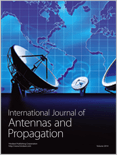
International Journal of Antennas and Propagation
Connecting research and application in antenna engineering.The International Journal of Antennas and Propagation, published by HINDAWI LTD, serves as a vital resource in the field of Electrical and Electronic Engineering, focusing specifically on advancements in antenna technology and propagation mechanisms. With an impact factor that reflects its academic rigor and relevance, this Open Access journal has been inviting submissions since 2007, ensuring that groundbreaking research is accessible to a global audience. Based in Egypt and distributed worldwide, the journal ranks in the Q3 category for Electrical and Electronic Engineering, situating it among the notable platforms for researchers seeking to disseminate their findings or stay abreast of the latest developments. It encompasses a wide scope, welcoming contributions that span theoretical studies, design innovations, and experimental validations, thereby fostering a comprehensive understanding of the subject. As it converges through the years from 2010 to 2024, the International Journal of Antennas and Propagation is a cornerstone for both emerging scholars and seasoned professionals aiming to enhance their knowledge and contribute to this dynamic field.
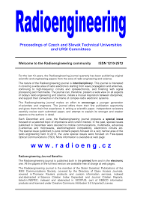
Radioengineering
Exploring the latest breakthroughs in wireless communication.Radioengineering is a prominent academic journal published by SPOLECNOST PRO RADIOELEKTRONICKE INZENYRSTVI, focusing on the fields of electrical and electronic engineering. Established in 1992, this open access journal aims to disseminate high-quality research and innovative developments in radioengineering and related disciplines. With an inclusive readership from around the world, it has been integral in fostering advancements in technologies such as wireless communication, signal processing, and electromagnetic theory. The journal's commitment to accessibility is underscored by its open access policy, allowing scholars and practitioners to freely engage with the latest findings. As of 2023, *Radioengineering* holds a Q3 quartile ranking in its field with a Scopus rank of #500/797, placing it within the 37th percentile among its peers. Researchers, professionals, and students engaged in electrical and electronic engineering will find *Radioengineering* an essential resource for both theoretical insights and practical applications. For further information, submissions, and access to articles, please visit the journal’s site linked through the CZECH TECHNICAL UNIVERSITY, located in Prague, Czech Republic.
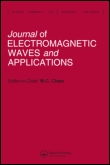
JOURNAL OF ELECTROMAGNETIC WAVES AND APPLICATIONS
Illuminating the Spectrum of Electromagnetic ResearchJournal of Electromagnetic Waves and Applications, published by Taylor & Francis Ltd, is a prestigious interdisciplinary journal that focuses on the rapidly evolving fields of electromagnetic waves and their applications. Since its inception in 1987, this journal has served as a vital resource for researchers, practitioners, and students interested in the latest advancements in electrical and electronic engineering, as well as materials science. The journal holds a respectable Q3 ranking in Electrical and Electronic Engineering and Electronic, Optical, and Magnetic Materials, and Q2 in Physics and Astronomy according to the 2023 category quartiles. With a dedicated readership, it aims to publish high-quality research articles that foster innovation and knowledge sharing among the scientific community. Despite not being open access, the journal ensures widespread availability of its insightful content aimed at pushing the boundaries of knowledge in the electromagnetic spectrum. As a crucial platform for disseminating cutting-edge research, the Journal of Electromagnetic Waves and Applications continues to contribute significantly to the advancement of technology and materials science.

JOURNAL OF COMMUNICATIONS TECHNOLOGY AND ELECTRONICS
Transforming Ideas into Innovations in Electronics.JOURNAL OF COMMUNICATIONS TECHNOLOGY AND ELECTRONICS, published by PLEIADES PUBLISHING INC, is a prominent academic journal dedicated to advancing the fields of communications technology, electronics, and materials science. With an ISSN of 1064-2269 and an E-ISSN of 1555-6557, this journal has been a pivotal resource since its inception in 1995, providing a platform for researchers and professionals to disseminate and explore groundbreaking studies and innovations up to the year 2024. Although currently categorized in Quartile 4 for Condensed Matter Physics and Quartile 3 for Electrical and Electronic Engineering, it continues to thrive in its role, offering insights and findings that contribute to its evolving impact within these disciplines. Researchers will find valuable content that emphasizes critical advancements in technology and materials, supported by robust Scopus rankings that highlight its competitive standing within its category. With no open access option, the journal provides exclusive access to its subscribers to delve into high-quality peer-reviewed articles, making it an essential resource for those at the forefront of scientific inquiry and innovation.
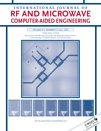
INTERNATIONAL JOURNAL OF RF AND MICROWAVE COMPUTER-AIDED ENGINEERING
Innovating Computer-Aided Design for Tomorrow's TechnologiesInternational Journal of RF and Microwave Computer-Aided Engineering, published by Wiley, is a leading peer-reviewed journal dedicated to advancing research in the realms of radio frequency, microwave engineering, and computer-aided design. With an ISSN of 1096-4290 and an E-ISSN of 1099-047X, this journal plays a pivotal role in the dissemination of innovative methodologies and state-of-the-art developments within these dynamic fields. Recognized within the Q3 category across three engineering and computer science domains as of 2023, it garners attention for its substantial contributions, ranking 40th among 106 in Computer Graphics and Computer-Aided Design and 327th among 797 in Electrical and Electronic Engineering according to Scopus metrics. Emphasizing its commitment to knowledge sharing, the journal provides a range of access options, including Open Access, to ensure the research is readily available to a global audience. Covering years from 1996 to 2024, the International Journal of RF and Microwave Computer-Aided Engineering continues to be an indispensable resource for researchers, professionals, and students in pursuit of excellence in engineering and applied sciences.
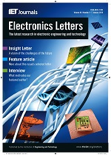
ELECTRONICS LETTERS
Pioneering Open Access for Global Impact.ELECTRONICS LETTERS, published by WILEY, is a leading peer-reviewed journal dedicated to the field of Electrical and Electronic Engineering. With a rich history dating back to 1965, this journal serves as a prominent platform for disseminating novel research and innovations in electronics, covering topics such as circuit design, telecommunications, and signal processing. In 2021, the journal transitioned to an Open Access format, ensuring that cutting-edge research is freely accessible to a global audience, thereby enhancing its impact and outreach. The journal currently holds a Q3 quartile ranking in its category, reflecting its solid position among its peers, and ranks #451 out of 797 in Scopus for Electrical and Electronic Engineering, placing it within the 43rd percentile. ELECTRONICS LETTERS is essential for researchers, professionals, and students looking to stay abreast of the latest developments and contribute to advancements in the field, fostering collaboration and knowledge sharing in a rapidly evolving landscape.

MICROWAVE JOURNAL
Connecting Professionals through Cutting-edge InsightsMicrowave Journal, published by Horizon House Publications Inc, is a well-established platform in the field of Electrical and Electronic Engineering, specifically focusing on the advancements and applications of microwave technology. Since its inception in 1969, the journal has consistently delivered high-quality research, making it an invaluable resource for professionals, researchers, and students alike. Despite its Q4 ranking in Scopus for 2023, the journal plays a crucial role in disseminating knowledge and fostering innovation within its niche, showcasing developments across various areas including microwave systems, components, and applications. Although it does not offer Open Access, the journal’s comprehensive insights and peer-reviewed articles are essential for anyone looking to deepen their understanding of microwave engineering. By maintaining a rigorous editorial standard, Microwave Journal continues to shape the discussion and evolution of microwave technology.

Progress in Electromagnetics Research-PIER
Pioneering Discoveries in Radiation and EngineeringProgress in Electromagnetics Research-PIER, published by EMW PUBLISHING, is an esteemed academic journal that stands at the forefront of the fields of Condensed Matter Physics, Electrical and Electronic Engineering, and Radiation. With an impressive impact factor reflected in its Q1 quartile rankings across these disciplines, PIER serves as a critical platform for disseminating high-quality research findings and advancements from 2000 onwards, with the latest contributions expected through 2024. The journal's commitment to excellence is evident as it holds prominent positions in Scopus rankings, including a remarkable 95th percentile in the field of Radiation. Researchers, professionals, and students will find PIER invaluable for accessing cutting-edge topics and methodologies that push the boundaries of electromagnetics research. For facile access, the journal is published in both ISSN (1070-4698) and E-ISSN (1559-8985) formats, ensuring that vital knowledge is readily available to its audience.

APPLIED MATHEMATICS AND MECHANICS-ENGLISH EDITION
Unveiling Innovative Solutions through Applied MathematicsApplied Mathematics and Mechanics - English Edition is a prestigious journal published by Shanghai University, focusing on the interdisciplinary applications of mathematics and mechanics across various scientific and engineering domains. With an ISSN of 0253-4827 and an E-ISSN of 1573-2754, this journal has established itself as a vital resource since its inception in 1980, extending its coverage well into 2024. The journal boasts impressive Scopus rankings—placing it in the top 10% of the Applied Mathematics category and the top 20% in Mechanical Engineering and Mechanics of Materials—reflecting its significant impact and contribution to research. Currently categorized in the Q2 and Q1 quartiles, it caters to a diverse audience that includes researchers, professionals, and students seeking to explore cutting-edge developments and innovative methodologies in the field. Although the journal is not open access, it remains committed to disseminating high-quality research that addresses contemporary challenges in applied mathematics and mechanics, fostering a deeper understanding of their practical implications.

Progress in Electromagnetics Research Letters
Transforming Ideas into Electromagnetic SolutionsProgress in Electromagnetics Research Letters, published by EMW PUBLISHING, is a vital peer-reviewed journal dedicated to the fields of electronics, optics, and magnetics. With an emphasis on innovative research and technological advancements, this journal has established itself in the academic community since its inception in 2008, and it will continue to publish valuable findings through 2024. The journal holds a respectable Q3 ranking in Electronic, Optical and Magnetic Materials, positioning it among the noteworthy contributions to the field, despite its percentile standing in Scopus. Researchers and professionals benefit from its commitment to disseminating high-quality research without the constraints of open access, ensuring that cutting-edge ideas reach a targeted audience. By fostering knowledge exchange, Progress in Electromagnetics Research Letters is poised to influence current and future advancements in electromagnetic technologies, making it a trusted platform for scholars and practitioners alike.